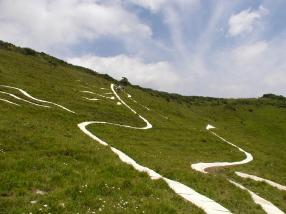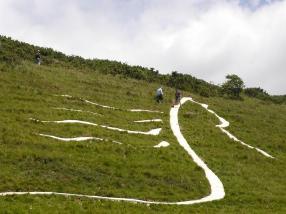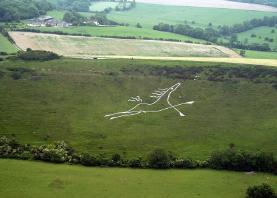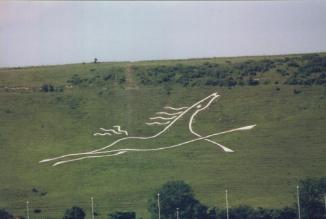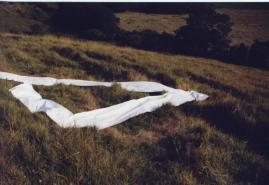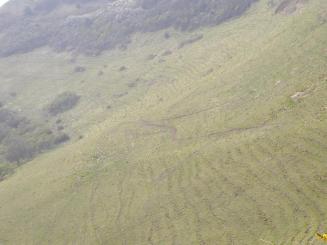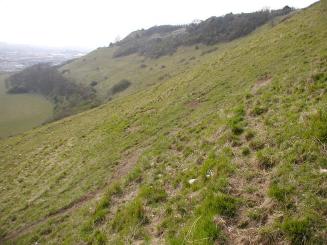Folkestone White Horse
Construction is now complete.
General Information
The folkestone white horse is now finished, following the construction of the trenches autumn 2003, work was started in May 2004 to make final adjustments to the trenches ready for the chalk / limestone slabs. The slabs were installed in June by most of the Folkestone horse team and a large number of Gurkas, stationed in Folkestone. They worked incredibly hard and construction was completed (apart from the eye) in about two weeks. The slabs were transported down the hill on sleds. The finishing touches were added shortly after.
Reproduced with kind permission of Dae Sasitorn and Adrian Warren - www.lastrefuge.co.uk
Slabs are cut to shape with a diamond cutter, the slabs are pinned down with large pins, and are joined together with pins pushed into holes drilled in the side of each slab.
The project started in 1998 and after 5 years work from a dedicated group of people it has become a reality.
A full size mock up of the horse made from white tarpaulin plastic was placed on Cheriton hill for a week at the end of August start of September 1999. It had to be removed due to English Natures intervention.
The mock up was 267' by 150'
Photos of the mock up
The horse is about 100 yds long
National Grid Ref TR 198 383
The best views are from Weymouth Rd (which is off Cheriton High St), M20 (J12 ) roundabout and the Tesco carpark off M20 (J12).
Kent does not have a white horse of its own, but several other figures, it is the proposal that the White Horse of Folkestone will be created to celebrate the millennium.
The proposal is to create a thin line chalk cut of a whitehorse on the escarpment of Folkestone Downs directly above the Channel Tunnel entrance, as a landmark to celebrate the coming millennium.
It would be a spectacle that is both "as old as the hills", recalling Britain's ancient Celtic heritage, with its tradition of chalk carvings, and a dramatic symbol of spirit and energ now, moving into a new time.
It is intended to divert the eye and help correct the natural imbalance that has been created with the construction of the Channel Tunnel. It would be a first, and last,
memorable glimpse of England for those passing by that route, and ideally situated to be seen clearly from the town itself.
Charles Newington the Artist, the artist, had the idea to create this extraordinary work of art nearly two years ago, and has been working on the project ever since.
The horse will be constructed by removing a layer of topsoil, then filling the resulting trench with chalk slabs. The length of the horse will be approx 100m long, and the trenches 12-24" wide. The work will be carried out entirely by hand under the supervision of a landscape architect and consultant experienced in this specialised field of land art construction. The maintenance involved is minimal a little weeding by hand.
A trust will be setup to maintain and protect the horse. It is a landmark designed to have a life-span of a thousand years - and for millennia to come - or for as long as the local community would wish it to be there. If at any time, it was not so, then the horse would disappear very quickly, through natural regeneration as many other figures have.
The land is classified as a site of special scientific interest and a candidate special area of conservation, being unimproved chalk downland with rare plant species. It is hoped that the horse will effectively act as a protector and guardian of the land it will be made on. The horse will be sited away from rare flora.
Everyone who has been consulted so far has given their enthusiastic support for the White Horse. It is hoped that the local community will be directly involved, with the children of Folkestone having their names and ages, and anything they might like to record about themselves being placed in a time capsule buried within the horse.
The horse has been completed in June 2003
Progress as to 4/03, trenches cut ready for chalk slabs
If you would like any information on the Folkestone White Horse or any other Hill figures,
E-Mail Me Mark Hows
This project is organised by Charles Newington and Richard Beaugie.
History
Progress

Maps
Plans
Artist Impression














